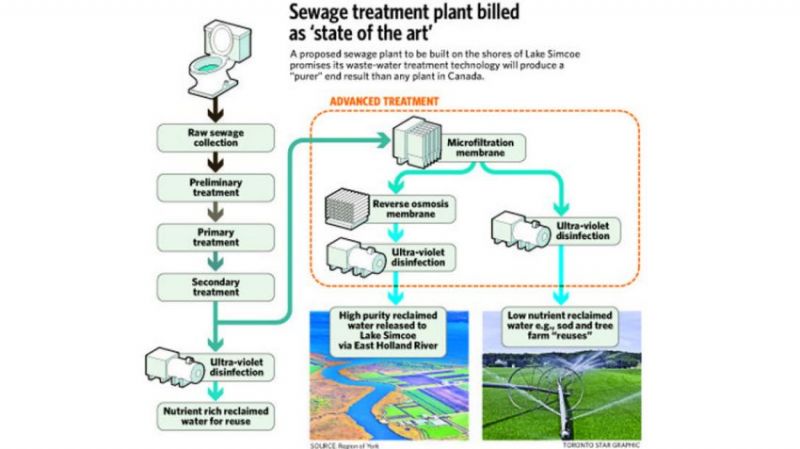Sewage Plant Technology Hailed as Most Advanced in Canada
Published on by Water Network Research, Official research team of The Water Network in Technology
Sewage plant technology hailed as most advanced in Canada, but proposed plant needed to accommodate growth in northern York Region has residents of Georgina Island worried about the future.

Mike Rabeau, the director of capital planning and delivery, environment services for York Region, says a proposed sewage treatment plant would allow further growth in York Region. Source: (CARLOS OSORIO / TORONTO STAR)
York Region is awaiting approval from the province on its $685-million Upper York Sewage Solutions project, which will release 40 million litres of treated sewage per day into the East Holland River — water that will eventually make its way into Lake Simcoe.
The plant is needed to accommodate growth in northern York Region, where development has been slow because of a limited amount of sewage infrastructure.
But strict provincial guidelines around the Lake Simcoe watershed, established because of high levels of phosphorus in the water, compelled the region to come up with a solution never seen before in Canada, said Mike Rabeau, York Region’s director of capital planning and delivery for environmental services.
“There’s nothing built like this in Canada,” Rabeau said. “And it’s well beyond anything already being done on the lake,” which is also home to 14 other sewage plants that have been dumping effluent into the lake for decades.
“The driver (for us) is really providing clean effluent into the natural environment, and supporting the rebuilding of Lake Simcoe,” he said.
But there are concerns among the Chippewas of Georgina Island First Nation around the effects of this water on the environment.
The Ministry of Environment and Climate Change says it is still consulting with all parties about the project.
Rabeau says conventional treatment in Ontario consists of two levels of treatment, including one that removes large particles, and uses biological processes to remove organic compounds from the water.
“With our plant, we have third level of treatment and fourth level of treatment, which is basically not done on treatment in Canada,” he said. These remove viruses, bacteria and protozoa from the water and essentially “disinfect” it.
“The level of treatment is extremely enhanced, and the water coming out is a very, very high purity,” he said.
The treatment will result in two effluents. One will be “high-purity reclaimed water” that will be released into the East Holland River, and will actually “enhance the water quality in the river,” which currently doesn’t meet provincial water quality standards, he said. The other is low-nutrient reclaimed water that can be used in farming.
York Region officials say they conducted a one-year pilot study for the membrane treatment and reverse osmosis technologies to test the water quality that was produced. They have also visited plants in California and Nevada, which have been using similar technology for years.
In an environmental assessment of the project online, the ministry says each “successive treatment level at a water pollution control plant provides an additional level of micro-constituent removal.”

Studies are also underway to investigate the effectiveness of different water treatment technologies in reducing pharmaceuticals and other contaminants found in wastewater across the province.
Source: The Star
Media
Taxonomy
- Sewage Treatment
- Raw Sewage Recycling
- Waste Water Treatments
- Wastewater Treatment
- Environment
- Sewage
- Sewage & Allied Waste
1 Comment
-
Bonjour
Cette usine de gestion des eaux usées dont le financement de son infrastructure doit être aussi élevé que son défaut primaire: l'épuration. Effectivement on peut remarquer les deux belles images de fond écologique.
Mais où est l'épuration des eaux usées?nulle part, nulle trace. Arroser de la biodiversité avec de l'eau non épurée est un crime contre l'humanité.
En quoi consite le traitement préliminaire? En quoi consite le traitement primaire? en quoi consiste le traitement secondaire ? la désinfection ultra violet désinfectge quoi? RIEN aucune fonction d'épuration.
La micro filtration a une efficacité toute relative puisque comme tout dispositif qui colmate il perd au fur et à mesure de son emploi de sa performance.
A part retenir toute forme de matière solide, on ne voit nulle part la fonction d'épuration du liquide. Celui-ci contient de la pollution dissoute: chimique, urinaire, désinfectant, aseptisant, déboucheur chimique, acide chlorhydrique et autres produits chimiques industriels.
Le liquide en sortie de cette usine est tellement débarrassée par le principe de la filtration de tout élément flottant que même les bactéries mortes sont retenues dans la filtration.
La filtraiton doit s'effectuer dans le second traitement: des planches de terre sablonneuse qui retiennent toute particules solides et ne laissent passer que du liquide.
Mais dans cette présentation hors norme je cherche désespéremment une trace des graisses ??? des boues d'excréments??? Que deviennent-elles? le suivi de ces résidus de boues?
Graisses et boues d'excréments sont imprégnées de chimique. qu'en fait-on? Epandues en terre agricole sous forme de compost? un moyen d'empoisonner la base alimentaire.
incinérer?. encore un moyen d'empoisonner l'atmosphère de la population, ce qui augmentera le budget de la santé.
L'avantage de l'assainissement Biologique: moins cher, moins d'infrastructure, efficacité de 100%, suppression de tout rejet pollué dans l'environnement, protection alimentaire des populations, amélioration de la santé, réduction du côut de la gestion des excréments. Une solution globale, définitive, économique, écologique, biologique productive.
English
Hello This plant of wastewater including the funding of its infrastructure management should be as high as its primary flaw: purification. Actually one can notice two beautiful green background images.
But where is the purification of sewage? anywhere, no sign. Water biodiversity with the not purified water is a crime against humanity.
What is the preliminary treatment? What is the primary treatment? What is the secondary treatment? ultra violet desinfectge disinfection what? NOTHING no purification function.
Micro filtration has a relative since efficiency as any device that seals it loses as his job with his performance.
Apart from holding any form of solid matter, we see nowhere liquid purification function. This contains dissolved pollution: chemical, urinary, disinfectant, Sanitizer, chemical unblocker, hydrochloric acid and other industrial chemicals.
The liquid output of this plant is so cleared by the principle of filtration of any floating element that even dead bacteria are retained in the filter.
Filtration should be carried out in the second treatment: boards of sandy earth that hold any solid particles and let liquid.
But in this presentation out of standard I'm looking desperate one trace fat? sludge of excrement? What happens to them? the follow-up of this residue of sludge?
Fat and sludge of excrement are steeped in chemical. What do we? Epandues agricultural land in the form of compost? a way to poison the food base.
incinerate? still a way to poison the atmosphere of the population, which will increase the health budget.
The advantage of biological sanitation: cheaper, less infrastructure, 100% efficiency, removal of any release polluted environment, food protection of populations, improvement of health, reduction of the cost of the management of feces. A comprehensive, definitive, economic, ecological, biological solution productive.